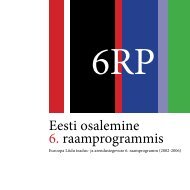Reactive Systems: Modelling, Specification and Verification - Cs.ioc.ee
Reactive Systems: Modelling, Specification and Verification - Cs.ioc.ee
Reactive Systems: Modelling, Specification and Verification - Cs.ioc.ee
You also want an ePaper? Increase the reach of your titles
YUMPU automatically turns print PDFs into web optimized ePapers that Google loves.
130 CHAPTER 6. HML WITH RECURSION<br />
Note that the successor configuration of (s, X) is always uniquely determined <strong>and</strong><br />
we will denote this move by (s, X) → (s, FX). (It is suggestive to think of these<br />
moves that unwind fixed points as moves made by a refer<strong>ee</strong> for the game.) Simi-<br />
larly successor configurations selected by the attacker will be denoted by A → moves<br />
<strong>and</strong> those chosen by the defender by D → moves.<br />
We also notice that every play either<br />
• terminates in (s, tt) or (s, ff), or<br />
• it can be the case that the attacker (or the defender) gets stuck in the current<br />
configuration (s, [a]F ) (or (s, 〈a〉F )) whenever s a , or<br />
• the play is infinite.<br />
The following rules decide who is the winner of a play.<br />
• The attacker is a winner in every play ending in a configuration of the form<br />
(s, ff) or in a play in which the defender gets stuck.<br />
• The defender is a winner in every play ending in a configuration of the form<br />
(s, tt) or in a play in which the attacker gets stuck.<br />
• The attacker is a winner in every infinite play provided that X is defined via<br />
X min<br />
= FX; the defender is a winner in every infinite play provided that X is<br />
defined via X max<br />
= FX.<br />
Remark 6.1 The intuition for the least <strong>and</strong> largest fixed point is as follows. If X is<br />
defined as a least fixed point then the defender has to prove in finitely many rounds<br />
that the property is satisfied. If a play of the game is infinite, then the defender<br />
has failed to do so, <strong>and</strong> the attacker wins. If instead X is defined as a largest fixed<br />
point, then it is the attacker who has to disprove in finitely many rounds that the<br />
formula is satisfied. If a play of the game is infinite, then the attacker has failed to<br />
do so, <strong>and</strong> the defender wins. <br />
Theorem 6.3 [Game characterization] Let (Proc, Act, { a →| a ∈ Act}) be a labelled<br />
transition system <strong>and</strong> F a formula of Hennessy-Milner logic with one (recursively<br />
defined) variable X. Let s ∈ Proc. Then the following statements hold.<br />
• State s satisfies F if <strong>and</strong> only if the defender has a universal winning strategy<br />
starting from (s, F ).<br />
• State s does not satisfy F if <strong>and</strong> only if the attacker has a universal winning<br />
strategy starting from (s, F ).
















